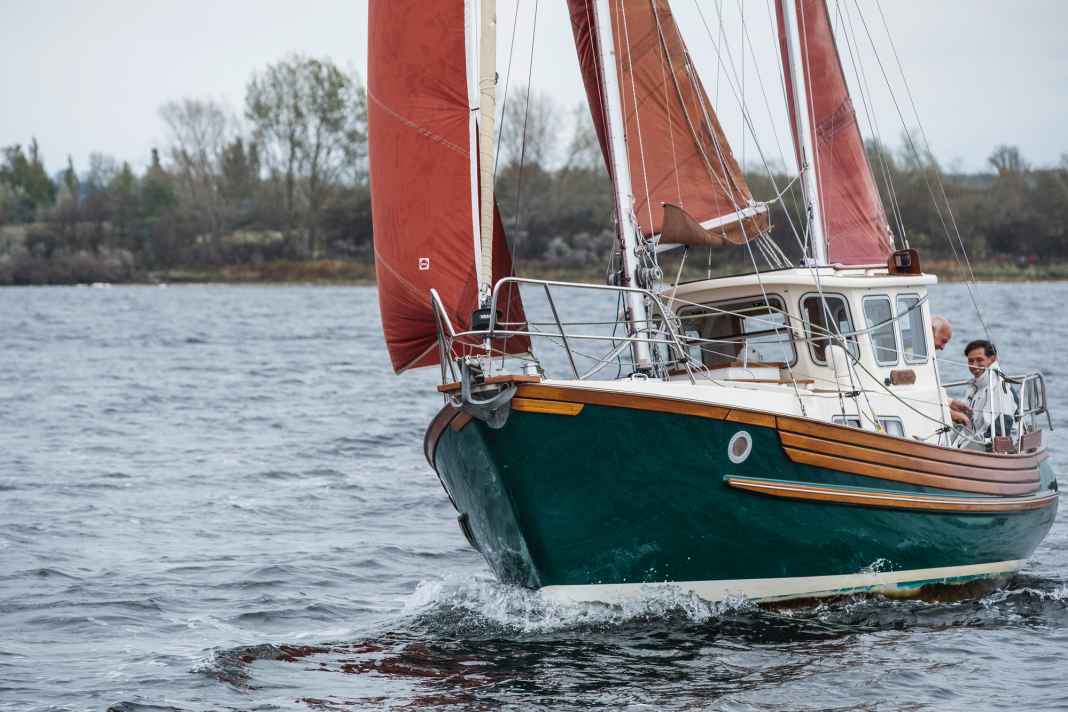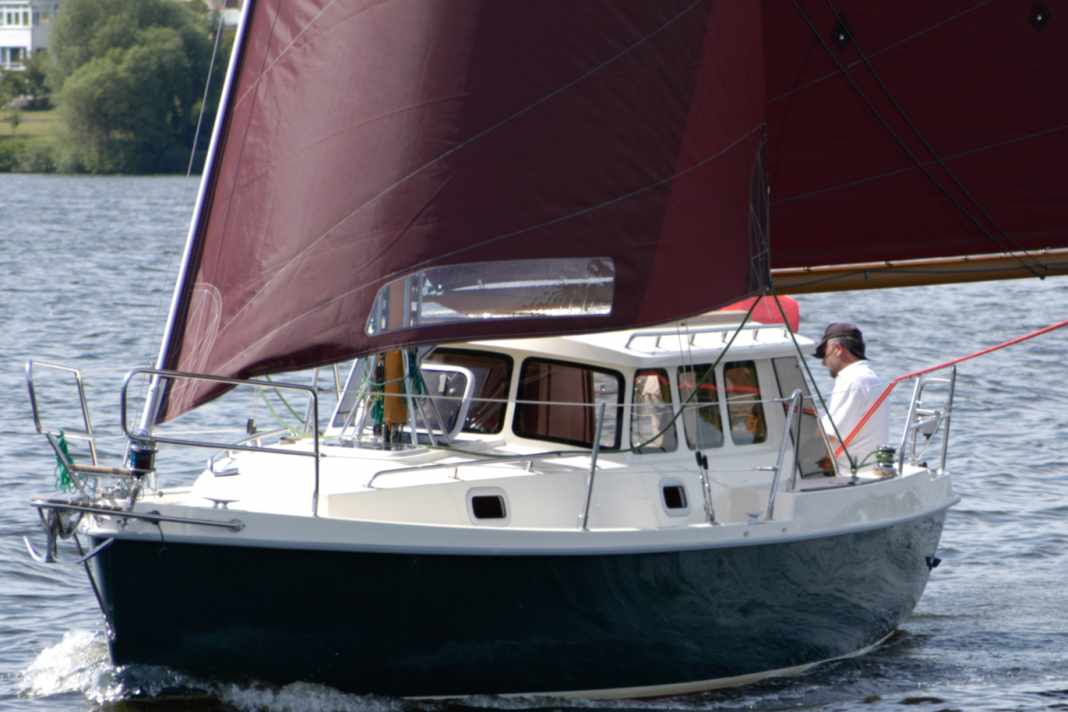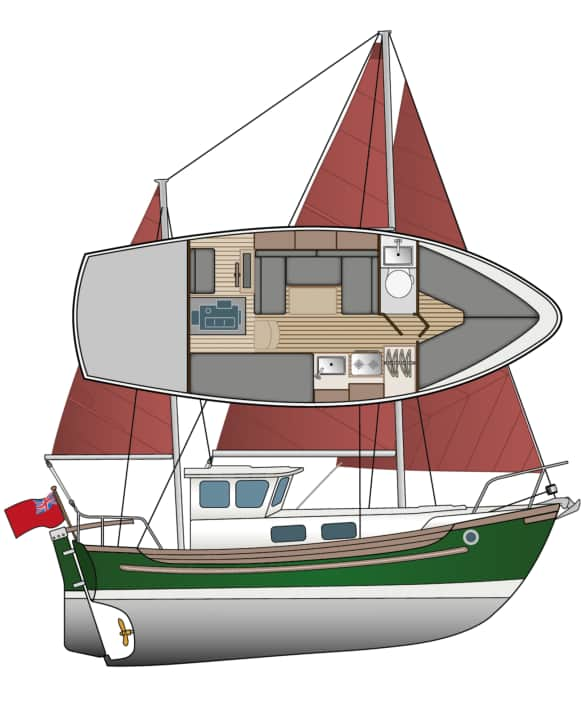





There are boats that everyone knows. The Fisher 25 is one of these, even though only 270 of them were built. However, the striking appearance of the small fishing cutter replica is memorable to anyone who has ever seen the individual vessel in harbour or at sea. And that can happen anywhere, because the motorised sailing boat built in southern England between 1975 and 2008 was delivered worldwide - always on its own keel.
This is surprising considering the size of the boat, because at 25 feet, the mini ketch still has the dimensions of a small cruiser. But once on board, you quickly forget that the hull is no longer than a folk boat. The forecastle deck creates a large foredeck area, the high bulwark conceals a huge superstructure, and the cockpit, deckhouse and cabin create several living spaces with a completely unique atmosphere. In short, you really feel like you're on a real ship. Perhaps the smallest in the world on which such a feeling can arise.
More used boats in the test:
The testers of YACHT felt the same way. "Anyone who loves fishing cutters will also love the Fisher 25," wrote editor-in-chief Harald Schwarzlose more than forty years ago in issue 4/1976, explaining that the extremely solid construction also followed the visual model. A boat weight of 4.5 tonnes, two of them in the keel, was astonishing even back then, given its size.
But the concept ensures longevity, as a visit to Rerik shows. "Only after many years of daily use can the quality and value of a sailing yacht be assessed by an expert inspection," wrote YACHT reader Kurt Ledtje, inviting him to test his 25-year-old "Rodina" as a second-hand boat. "Nothing creaks or cracks anywhere here," says the convinced owner as he welcomes us on board.
Life on board at sea and in the harbour regardless of the weather
Ledtje had viewed his boat at the London exhibition and commissioned it. In April 1995, he delivered it - on his own keel, of course - in five days from the Solent to the Elbe in Hamburg, where he lived at the time.
The usual delivery time at the time was one year, and Ledtje had no special requests. He could also have had a slip rig with white sails or a saloon with dinette below deck, for example. At Northshore Yachts Yard Limited in Itchenor, where the Southerly and Vancouver yachts are also built, almost anything is possible. In 1981, they took over the production of Fairways, where the Fisher 25 designed by Gordon Wyatt and David Freeman has been built since 1975.
At the time, the two yacht designers wanted to build on their success with the Fisher 30. With its cutter look, ketch rigging, canoe stern and wheelhouse, this motorsailer, which was consistently designed for weather-independent living on board at sea and in the harbour - even in extremely cold and hot regions - quickly found its fan base, for whom it is still regarded as the bluewater boat of this size par excellence. Among connoisseurs, the boats built later by Northshore enjoy the reputation of being of a higher quality than those of the early years. However, there were no real changes.
About ten years ago, the mould was sold to the largest shipyard in Asia, Neil Marine in Sri Lanka, where the Fisher 25 can still be built. Her designers, Wyatt and Freeman, have given the model a slight facelift. For example, the toilet room was moved from the front to the centre of the boat, resulting in a modified saloon. The photos of the prototype are available on the shipyard's website (www.neilmarine.com) can be seen.
Contrast between work vehicle and yacht
It is already late in October when owner Kurt Ledtje welcomes us on board and leads us aft across the deck. The 25 is the only one in the Fisher family to have a transom rather than a canoe stern, resulting in an extremely spacious, self-draining cockpit that takes up the entire space of the hull behind the wheelhouse.
A sliding door leads to the interior of the wheelhouse. Here, the helmsman sits on a small bench behind the wheel and fittings on the port side and has a good view in all directions through the windows and skylight. The headroom is limited at around 1.80 metres. There is a bench on the starboard side that can be pulled out to increase its surface area. There is room for two or, if necessary, three people in the deckhouse, which is also easy to steer from under sail.
The solid teak and teak-veneered plywood interior clearly demonstrates the high standards of the shipyard and the Scandinavian boatbuilding model. The supposed contrast between work boat and yacht is obviously being flirted with, as can be seen from the very first sentences of the advertising brochure. There it is stated - in the absolute limit of British understatement - that the Fisher yachts are "recommended by their owners as the finest of their type".
Much more impressive, however, is the amount of space and its utilisation. "We consider the design of the Fisher 25 to be optimal in relation to its size," wrote the testers back in 1976. "You can hardly get more comfort out of a boat of this size."
The saloon has a headroom of 1.80 metres and offers enough space for three people. A large L-shaped sofa berth on the port side can be converted into a double berth. To do this, the standard long forecastle is lowered, which can also be folded up at the aft bulkhead, resulting in a completely free space below deck. On the test boat, a fixed table was retrofitted to create a spacious U-shaped sofa berth.
The weather is outside
To starboard is a dog bunk with a pull-out navigation table above it. In front of this, at the quietest point of the boat at sea, is a comfortable galley with sink, semi-cardanically suspended cooker with oven, drawers and storage compartments for crockery. A refrigerator compartment is fitted under the dog bunk on the shipyard side.
There is a toilet room on the port side in front of the saloon, which is naturally very small but offers all the usual functions. Opposite, there is a locker with a louvre door and a spacious foredeck with very high berths, two portholes in the side wall and storage areas. The tank capacity is ample with 180 litres for fresh water and diesel.
The engine is operated from the inside steering position. With its 27 hp, the Yanmar 3 GM delivers a good 5 knots of cruising speed at 2200 rpm. The drive technology is installed under the wheelhouse, where the floor can be completely removed in a few simple steps. This creates an engine compartment with plenty of space for maintenance work.
As the engine runs, an unusual sailing day begins here at the wheel in the wheelhouse - because the weather isn't there; it's happening outside the window. You can see the trees bending on the shore, rain showers chasing across the salt lagoon, but the door is closed and none of that bothers us inside. The comfort zone only needs to be left for the sailing manoeuvres.
The handy cloths are set quickly and the first thing to do is head into the wind. Around 50 degrees of true wind are possible. But cruising long distances upwind under sail is not what this small motorised vessel is designed for. And on all other courses, it is attested good cruising speeds and pleasant sea behaviour under sail.
No known structural problems with the Fisher 25
The day on the Salzhaff confirms this. The "Rodina" moves calmly like a larger yacht. The inboard steering mechanism is disconnected for sailing, and the boat can then be sailed very directly with the tiller, giving the helmsman a clear view forwards past the superstructure. As it is very stable on course, the rudder can also be left to its own devices for short periods.
In YACHT 4/1976, the tester at the time, Schwarzlose, described how the Fisher 25 sailed in "really rough weather", when the crew had to cope with "7-8 Beaufort and rough, onshore seas" off Damp. The compact motorsailer behaved like a typical cutter, ponderous and good-natured. "There is no hectic pace on board. 4.5 tonnes of weight determine the movements. The boat also takes its time with heeling. It sails rather upright, similar to a Dutch flat-bottomed yacht, and so the stay in the cabin and wheelhouse is always pleasant."
Due to the solid construction, only a few of the usual signs of ageing are typical of ageing Fisher 25s. It is known from boats built before 1990 that the window frames in the wheelhouse become leaky due to corrosion and then have to be replaced. In the same period, the Treadmaster deck covering was not yet glued on with epoxy resin, resulting in signs of peeling. Structural problems, which usually occur at critical points after a certain period of use, are not known.
Anyone looking for a solid and compact boat for sailing in all weathers should take a closer look at this small cutter. It is perhaps difficult to measure by the usual standards. However, Fisher motorsailers have enjoyed cult status among their fans since day one. There are active owner associations in Great Britain, Holland and Canada. But meetings are also organised here in Germany from time to time. Kurt Ledtje was always there. The first owner has been spending the summer on his "Rodina" for 25 years, travelling around 1000 nautical miles per season. He would not consider any other boat for this - which is also a kind of test result.
The relationship



- Colvic Watson 26: Solid motorsailer in cutter style from Scotland. Large cockpit with steering position in the open aft superstructure
- Dartsailor 27: Motorsailer with deck saloon and inside steering position from the Netherlands. Was also built with aft cabin
- Haber 800: Polish pilothouse yacht with a shallow draught and plenty of living comfort. Still being built, in numerous variants
- Hunter Pilot 27: Chine keeler with deck saloon and inside steering position from England. Pure sailing yacht, very comfortably equipped
- Jutahela Marina 75: Nautical motor glider in GRP-wood composite production from Finland. Inside steering position in the closed deckhouse
- Putty 25: Danish motor sailer with aft cabin and large cockpit with steering position in the open aft superstructure
- LM 26: Very good sailing motorsailer from Denmark. Inside steering position and galley in the wheelhouse, spacious cockpit
- Mascot 24: Danish motorsailer with large saloon below deck. Steering position under the superstructure open aft
- Møn 27: More of a motorboat with auxiliary sails. Aft cabin and centre cockpit. Steering position and galley under open superstructure
- Winga 78: Very spacious and comfortable motor glider with aft cabin and centre cockpit, sheltered driving position and tiller
The Fisher 25 in detail

Technical data of the Fisher 25
- Design engineer: Wyatt & Freeman
- Shipyard: Northshore Yachts Yard Ltd
- Construction method: GRP solid construction
- Total length: 7,69 m
- Waterline length: 6,40 m
- Width: 2,85 m
- Depth: 1,13 m
- Weight: 4,5 t
- Ballast/proportion: 2,0 t/45 %
- Mainsail: 9,3 m²
- Besan: 4,2 m²
- Genoa: 14,0 m²
- machine (Yanmar 3 GM): 19.8 kW/27 hp
- Fuel tank: 180 l
- Fresh water tank: 180 l
- Number of units (built 1975-2008): 270
Prices
- Base price ex shipyard 2008: 100.000 €
- Used boat price: 30.000-50.000 €
As of 02/2025, how the prices shown are defined, read here!
YACHT review of the Fisher 25
A real character boat for cruising under sail and motor, regardless of the weather. Comfortable and seaworthy
Design and concept
Extremely solid construction
Successful compromise between motor and sailing boat
Easy to control from the inside in all conditions
Large cockpit
Sailing performance and trim
Pleasant sea behaviour
Good all-round characteristics for a motorised glider
Little height on the wind
Living and finishing quality
High-quality finish in teak
Little headroom in wheelhouse
Very small WC room

